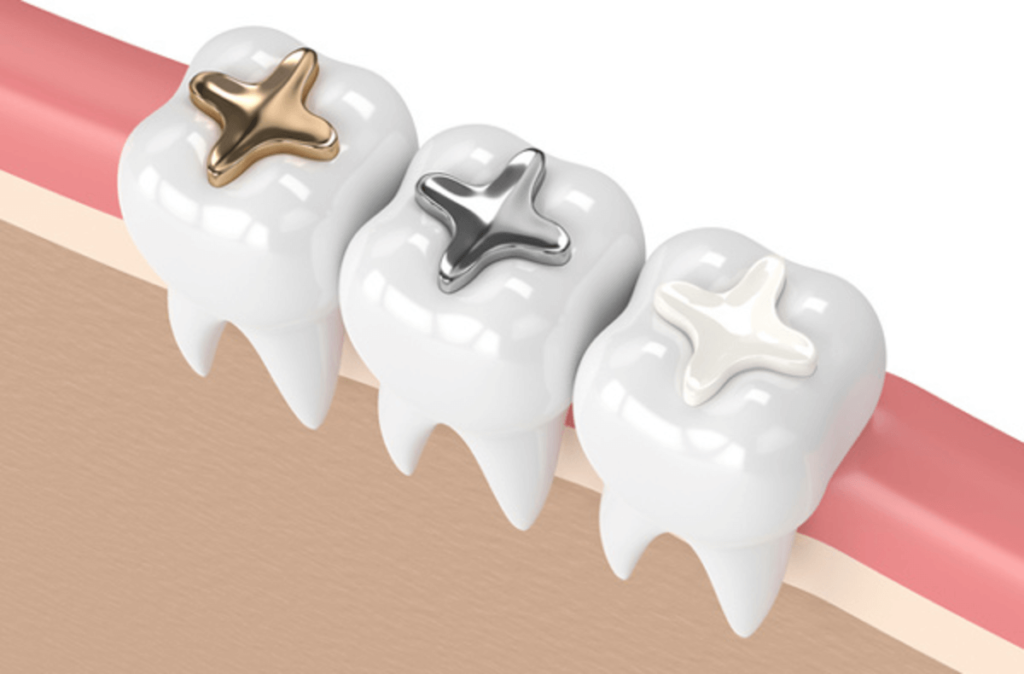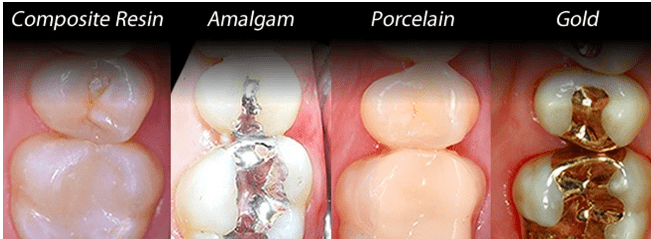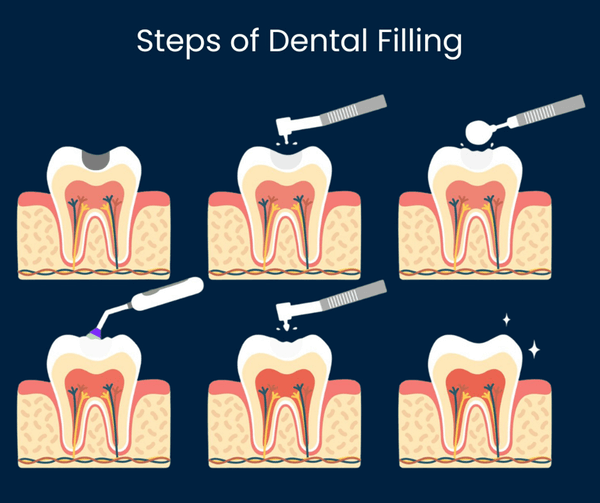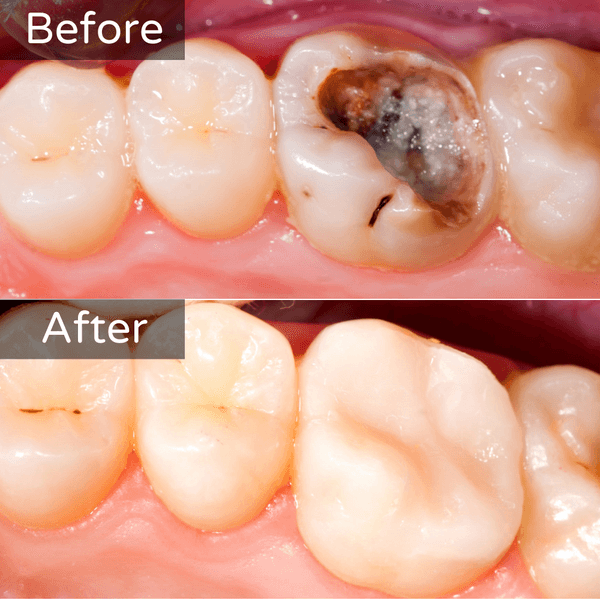Dental tooth filling is one of the most performed procedures in dentistry. This procedure helps to restore the function and structure of decayed teeth. Fillings are an important part of dental care because they don’t just repair cavities but also prevent further damage.
Different materials are used for the dental tooth filling procedure. Common materials include amalgam, resin, gold, ceramic, and ionomer. Understanding the dental tooth filling procedure, types, aftercare, and benefits will help you make an informed decision about oral health.
This article covers everything you need to know about dental fillings, including their types, procedures, benefits, and aftercare.

What is Dental Tooth Filling?
Teeth filling method is a restorative procedure used to repair minor tooth damage caused by cavities, cracks, or fractures. If you have poor oral hygiene, bacteria can erode the tooth’s enamel, causing small holes (cavities). When these cavities are left untreated, they can lead to pain and infection.
During the dental tooth filling procedure, the dentist will remove the decayed portion of the tooth and fill the space with suitable material. Dental filling process will restore the tooth’s structure, prevent further decay, and help maintain its function.

Types of Dental Tooth Filling
Dental fillings are available in various materials. The choice of material depends on factors such as location, durability, cost, and aesthetic preference. How much does a filling for a tooth cost? The price varies depending on the material used and the complexity of the procedure. For example, composite fillings are more affordable than gold or ceramic ones. Here are different types of dental tooth filling materials:
Amalgam Fillings
Amalgam fillings are made from a mix of silver, mercury, tin, and copper. They are cost-effective and highly durable. Commonly amalgam fillings are used for molars and back teeth. The reason behind this is their noticeable silver color.
Composite Fillings
Composite fillings are ideal for front teeth and visible areas. Because they are made of a tooth-colored Dental Resin that blends naturally with teeth, they are less durable, lasting around 5-7 years.
Gold Fillings
Gold dental fillings are extremely durable and long-lasting. While they are highly effective, they are also expensive. Getting a gold dental filling requires multiple visits to a dental clinic.
Ceramic Fillings
Ceramic fillings are made from porcelain and offer a natural tooth color. One of their advantages is high resistance to staining. They are more aesthetically pleasing but can be brittle.
Ceramic fillings made from high-quality zirconia material offer natural tooth color and stain-resistance.
Aidite is a leading provider of integrated dental solutions, offering products such as Superfect Zir and AIZIR Zirconia. These materials enhance the durability and aesthetics of ceramic fillings.
Glass Ionomer Fillings
Glass ionomer fillings are made from acrylic and glass. They release fluoride which helps to prevent further decay. They are commonly used for children’s teeth or in areas that don’t endure heavy chewing pressure.
Dental Tooth Filling Procedure
The dental filling process is usually straightforward. However, many people wonder, is a tooth filling considered surgery? No, it is a minimally invasive non-surgical procedure. Here is step-by-step breakdown:

Step 1: Initial Examination & Diagnosis
The process starts with an initial consultation with the dentist. The dentist will examine the affected tooth using a dental probe, X-rays, or digital imaging to assess the extent of decay or damage. If a cavity is detected, a filling is recommended. Based on the severity of the cavity dentist will recommend the appropriate type of filling (e.g., composite, amalgam, glass ionomer).
Step 2: Anesthesia Administration
To ensure a painless procedure local anesthesia is given to numb the area around the affected tooth. Either numbing gel is applied or an anesthetic like lidocaine is injected near the tooth’s nerve.
Step 3: Removal of Decay/Damaged Area
The dentist uses a dental drill or laser to remove the decayed portion carefully. Some dentists also use laser technology for a more precise removal. They try to preserve as much healthy tooth structure as possible.
Step 4: Tooth Preparation
The next step of the dental tooth filling procedure is tooth preparation. After removing the decay, the dentist cleans the cavity to eliminate bacteria and debris. If the decay is deep, a liner or base may be placed to protect the tooth’s nerve.
Step 5: Filling Placement
The chosen filling material is placed into the cavity. If using composite resins, the dentist applies the material in layers and hardens it with a special curing light.
Step 6: Shaping & Polishing
Once the filling is securely in place, the dentist shapes it to match the natural contours of the tooth and polishes it for a smooth finish.
Aftercare for a Dental Filling
Proper care after dental tooth filling procedure helps prolong the life of fillings. It also helps in maintaining oral hygiene. Here are some things you should keep in mind after a dental tooth filling procedure:
- You should avoid eating hard or sticky food for the first 24 hours.
- Brush twice daily and floss regularly to maintain good oral hygiene.
- Visit your dentist for routine checkups to monitor the filling’s condition.
- After the dental tooth filling procedure, you might have some sensitivity to hot or cold foods, which may last a few days after the procedure. So be careful.
- If you feel discomfort or pain or the filling feels too high or causes bite problems report it to your dentist.
Benefits of Dental Tooth Filling
Dental tooth filling offers several benefits, here are some of them:
Restores Tooth Function
Due to cavities, the structure of the tooth gets damaged. A damaged tooth cannot function properly. It makes biting and chewing difficult. Dental tooth filling restores the structure of the tooth, which improves tooth function.
Prevents Further Decay
If you have untreated decay it can lead to a lot of other problems. Cavity increases the risk of gum diseases and tooth loss. Getting a dental tooth filling blocks the bacteria from entering deeper layers of the tooth. In this way, dental tooth filling reduces the risk of further complications.

Reduces Tooth Sensitivity
When a tooth has decay, cracks, or enamel erosion, the underlying dentin and nerves become exposed. This causes sensitivity to hot, cold, sweet, or acidic foods. A dental filling seals these exposed areas, acting as a protective barrier that prevents further irritation.
Improves Aesthetics
Dental tooth fillings especially tooth-colored ones closely match the natural shade of teeth which makes them nearly invisible. Composite resin or porcelain fillings enhance the tooth’s appearance and also provide a cosmetic improvement.
Cost-Effective and Quick Solution
Compared to other dental procedures like crowns, root canals, or extractions, fillings are much more affordable. Dental tooth filling procedure is quick and can be completed in a single dental visit, often within 30–60 minutes.
FAQs related to Dental Tooth Filling Procedure
Is a tooth filling considered surgery?
No, the teeth filling method is not a surgery. It is a non-surgical, minimally invasive dental procedure. It involves cleaning out decay and restoring the tooth with a filling material.
How much does a filling for a tooth cost?
The dental tooth filling cost depends on factors like the material used and the location of the dental clinic. The general price range for composite resin filling can be between $200 and $400 for a single tooth, and ceramic, between $500 and $2800. Gold tooth fillings can be between $300 and $1000, and glass ionomer tooth fillings between $100 and $400.
What is a tooth filling procedure?
A dental tooth filling procedure involves a few steps. These steps include removing the decay, placing the filling, and then polishing the tooth.
Conclusion
In conclusion, dental fillings are essential for preserving oral health, restoring function, and preventing further decay. Choosing the right filling material depends on factors like durability, aesthetics, and cost. With innovations from companies like Aidite, modern dentistry continues to improve, offering more reliable and aesthetically pleasing dental solutions. Aidite is a leading provider of advanced dental materials, specializing in zirconia ceramics and digital dental solutions. Their high-quality materials enhance the durability and aesthetics of dental restorations, including fillings, crowns, and bridges.



